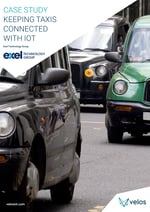
A Quick Guide to
IoT Asset Tracking
This guide will cover everything your organisation needs to know about IoT asset tracking. We’ll go through the basics, covering the different types of asset tracking solutions available to you, the benefits effective asset tracking can reap, and various use cases for real-time IoT asset tracking.
What is IoT asset tracking?
IoT asset tracking is the application of IoT technology to asset management. It connects tagged items in your inventory - transportation, people, shipments and such - to your asset management ecosystem and gives real-time insights into where each item is in the world, how far along it is in your supply chain, and how long it takes each item to move through it.
Many industries can minimise human errors, losses and theft by replacing manual asset management with real-time location systems (RTLS) tracking. Gaining real-time insights and data into what is happening to the asset can improve logistics, resource management and security.
This guide will cover everything your organisation needs to know about IoT asset tracking. We’ll go through the basics, the different types of asset tracking solutions available to you, the benefits effective asset tracking can reap, and various use cases for real-time IoT asset tracking.
Types of IoT asset tracking solutions
One of the first things you’ll want to decide on when investing in IoT asset tracking is the type of tracking technology to rely on. RTLS solutions have a broad range of use cases depending on what your business needs. Here are examples of the most popular tracking solutions:
Long and wide range asset tracking
GPS Asset Tracking
The Global Positioning System (GPS) is a satellite-based navigation system developed by the US Government. It uses global satellites to triangulate the location of an asset by sending and receiving several signal types to a set of 4 satellites in position. It is part of the GNSS and one of the GNSS's most accurate systems.
GPS trackers are the most widely used type of trackers, which makes them a ready-available low-cost option. They are also a suitable low-power option. Current system accuracy is within 3m or 95%.
The system is ideal for tracking assets that travel around the world on long routes and through remote locations.
GNSS / Satellite
Satellite tracking utilises the Global Navigation Satellite System (GNSS) that encompasses a number of international navigation systems, among which GPS, GLONASS, Galileo and BDS.
GNSS tracking determines the position of an asset by measuring the time it takes the signal to reach from orbit. Sending and receiving signals from the orbital satellite also means the strength of the signal is influenced by obstacles, so this type of tracking is not suitable for indoors and underground.
GNSS trackers are compatible with all navigation systems within the network, which makes them a good option for global-scale operations that require more frequent updates.
![]()
Cellular
Tracking assets with cellular connectivity relies on getting location data from nearby cell towers. Each tower location is mapped within a global database and when passing in the proximity of one, the tracker sends an update that is currently in its vicinity.
Cellular tracking is currently the most popular solution for IoT because it supports highly accurate location tracking with real-time and high-volume data capabilities.
This solution type is suitable for highly mobile assets, such as road vehicles and cargo, where location stamps and asset status data is needed at regular intervals.
With the advancement of 5G, cellular tracking accuracy is expected to increase even further.
LPWAN
Low Power Wide Area Networks are a subset of cellular connectivity that has been developed specifically for the IoT industry. It includes networking options like NB-IoT and LTE-M.
LPWAN solutions exist to make cellular connectivity more affordable, secure and less power-intensive by transmitting data with a shorter, weaker signal. While the hardware for LPWAN is similar in price to cellular, it can cut down on networking costs.
LPWAN solutions create an internal network subset, hence the increased security and are perfect for tracking assets within the designated area. Examples may include shipping docks, construction sites, farms and such, where the assets are expected to remain on-premise.
![]()
Short-range asset tracking
Ultra-wideband
Ultra-wideband has grown in popularity in recent years thanks to its high level of accuracy. It can detect assets with centimetres and remains accurate in the face of interference.
UWB uses precision tracking anchors to define an operational space and uses radio signals to track tagged assets within it. Because it uses a wide bandwidth, it does not interfere with other transmissions, making it ideal for indoor use cases.
Tracking with UWB is based on several methods. Your tracker can calculate positioning based on the signal send and arrive times or the angle of arrival.
UWB is a popular choice for warehouse logistics, entertainment, sports and any other case that requires high-precision tracking.
![]()
Wi-Fi
Wi-Fi is unique among the IoT asset tracking options thanks to its ability to transmit large quantities of data in a short amount of time. It’s fast and reliable, making it ideal for short-range data transmission.
On the other hand, Wi-Fi is less than ideal when it comes to accuracy. It relies on triangulation and is only accurate within 15m. It’s expensive as well, especially when supporting more than ten to twenty devices.
Wi-Fi uses RSSI technology, much like Bluetooth to track assets via the signal strength, and can leverage the angle of arrival in some cases.
Bluetooth
Tracking via Bluetooth is based on measuring the signal strength of the Bluetooth receiver compared to the Bluetooth beacons within range. This is the so-called received signal strength indicator or RSSI value.
With the advancement of Bluetooth 5.1. the technology has incorporated tracking via angle of arrival (AoA) and can produce real-time meter accuracy and direction-finding.
Much like UWB, Bluetooth tracking solutions are often used for indoor logistics, where you can set up the beacons and define the tracking space for the best results.
![]()
RFID tagging
The last type of IoT asset tracking to consider is RFID tagging. RFID is a passive form of asset tracking because it cannot pinpoint a device’s location. Instead, it just reports whether or not a particular RFID tag is within range of an RFID scanner.
For instance, you could have a handheld RFID scanner that only detects tags within a few centimetres of the scanner. Or you could have a scanner with up to 800m of range that alerts you whenever a tag enters that range.
Although RFID can’t provide precise location information or transmit data, it is available in various form factors and ranges. It doesn’t require a battery and is very low cost. RFID is highly susceptible to interference, though, which is important to keep in mind.
![]()
How IoT asset tracking works
Tags
In order to track an asset, it has to be visible to the asset tracking system. This could be done through the so-called ‘tag’ which transmits signals. Both short and long-range navigation systems require your asset to be able to send and receive on specific bandwidths. The tags can come in many forms and be built in or attached to the asset.
Connectivity Infrastructure
The connectivity infrastructure is the way to connect the tags to a system and locate them. GPS asset tracking, for example, would include a set of orbital satellites to which your asset would send signals. Cellular navigation would require cell towers, and indoor tracking would rely on connecting via beacons and anchors. Your infrastructure would need to send the location data back to a database.
Management Software
Asset location information needs to be sent to the business management software. The software identifies each of your tags and reads the data transmitted by your connectivity solution. You can use this system to view the location of your inventory in real time.
Velos IoT can also offer you the possibility to track and manage your cellular tracking IoT SIM tags via the Nomad Connectivity Management Platform. Integrate it with your existing software for a complete overview of your asset locations and data usage.
The benefits of IoT asset tracking
Track your assets in real-time
The core benefit of IoT asset tracking is that it provides real-time insights into the location of your inventory items. IoT asset tracking lets you offer more precise shipment tracking to customers and build more advanced insights into your logistics timeline.
Depending on your operation, real-time asset tracking can be fully automated. Automated monitoring not only provides real-time location insights, but it can do so instantly at all hours.
Prevent theft and losses
IoT technology makes it much easier to reduce theft and loss as well. You immediately know when an item is moved without authorisation, reducing the time between loss and discovery of a loss.
Additionally, it’s easier to find items because they have built-in tracking. So whether an item was stolen or lost within your system, you can recover it faster and more reliably.
Save time and reduce disruptions
There are several ways you can use IoT asset tracking to save time and reduce disruptions in your logistics.
It’s more accurate and automatic than manual methods, reducing errors and hangups.
You can use the real-time data you collect through IoT tracking to find slow points and issues in your supply chain, highlighting potential solutions.
Finally, because IoT asset tracking is automatic, you can save person-hours for every item moving through your inventory.
Boost sustainability efforts
One significant long-term benefit of investing in IoT asset tracking is its potential to boost your sustainability efforts.
For most businesses, their supply chain accounts for 90% of their environmental impact. Making this impact positive is essential to promoting sustainability, winning over customers, and adhering to regional requirements.
To reduce this footprint, though, you need data. IoT asset tracking can provide you with this data, empowering you to strive towards carbon neutrality.
Industry use cases and applications
IoT asset tracking can be helpful in many different industries, including:
Transportation
 IoT asset tracking can be especially useful in transportation. You can track fleets of vehicles like taxis or busses and keep track of maintenance requirements for each vehicle, optimise their routes and monitor fuel consumption.
IoT asset tracking can be especially useful in transportation. You can track fleets of vehicles like taxis or busses and keep track of maintenance requirements for each vehicle, optimise their routes and monitor fuel consumption.
Read how our partners at Exel Technology tackle taxi fleet tracking and management with the Velos IoT cellular solution.
Healthcare
Did you know that hospitals need to keep track of massive inventories? They need to monitor every medical instrument, gauze pad, wheelchair, and medication cart. IoT asset tracking technology can help hospitals efficiently manage their equipment.
Manufacturing
The manufacturing industry can put IoT asset tracking to use in a variety of ways. Bluetooth, UWB and RFID technologies can help reduce human error when scanning and tracking components or help expeditors find missing parts that haven’t made it from one workstation to another.
Logistics

Keeping track of a supply chain is a lot of work with many different stages. IoT solutions can help you track where goods are in the supply chain, keep drivers safe using IoT sensors, and even provide you with actionable data about fast-selling assets and stock to help your business grow.
Optimise your supply chain with real-time monitoring and actionable data about delivery status, item conditions and vehicle maintenance. Increase security and reduce the chance of tempering with high-value items en route.
Construction

Construction equipment is expensive, and equipment theft from work sites can be a serious concern. IoT asset tracking can let you know as soon as a piece of equipment leaves a specified geofenced location to help prevent theft and loss.
Agriculture
As one of the world’s oldest industries, agriculture has seen plenty of innovations. Using IoT asset tracking solutions can help farmers manage the condition of their equipment, monitor supply levels, and see the location data of livestock.
Pet monitoring
Having a pet go missing is a stressful, potentially heart-breaking experience. With IoT asset tracking, you can keep track of your dog or cat with collars or tags that use cellular technology.
Law enforcement
Law enforcement organisations can use IoT asset tracking to monitor everything from weapons to patrol cars to police officers themselves. Tracking can be beneficial for directing teams of backup officers to specific locations.
Education
IoT asset tracking helps teachers keep track of school-issued laptops or tablets and can allow administrators to keep an eye on an entire school district’s inventory.
The Velos IoT approach

For IoT asset tracking to work properly, it needs to balance mobility with accuracy. On their own, it can seem like the available types of asset tracking require that you choose between the two, but many solutions on the market offer hybrid technologies that utilise two or more tracking systems.
At Velos IoT, we specialise in cellular tracking for both single and hybrid tracking solutions. Velos IoT can provide you with the cellular solution you need to create a seamless, accurate asset-tracking system. And thanks to Velos IoT’s truly global network, you’ll be able to track your devices as they travel around the world accurately.
If loss of network and oversight of your assets aren’t a compromise your business is willing to accept, reach out to the team at Velos IoT today.
We can provide you with the latest cellular asset tracking technology and the management platform you need to keep things simple and efficient.
Choose Velos IoT
Velos IoT's non-steered, open-roaming IoT SIMs are designed with no additional software to get in the way and delay connections. Plus, we allow free hopping between all the networks available in a particular country, with dynamic IP addresses, fixed IP or IP SEC VPN.
Velos IoT SIMs Features:
Non-steered, open-roaming SIMs
Free network attaches and detaches from every network in the UK and 600+ networks globally. Absolutely no logic on the SIM or in the Velos IoT network that prefers a particular provider unless upon request.
Global resilient connectivity
With 600+ roaming agreements in over 210 countries and territories, Velos IoT has the best-in-class global network coverage, which means your devices will spend less time searching for networks and stay connected at all times.
Dynamic coverage control
Velos IoT's open-roaming IoT SIMs ensure your devices keep connected to the most robust network available. If a single device is having issues, it will temporarily be removed from a network, and the SIM rebooted and re-tested, which eliminates the mobile network as a cause of problems.
Support for all SIM form factors
Velos IoT's SIMs are available in all SIM Form Factors: Standard SIM (2FF), Micro SIM (3FF), Nano-SIM (4FF), and QFN8/MFF2 Chip.
Managed by our Nomad Connectivity Platform
All IoT SIMs and connectivity are managed by our unique Nomad Connectivity Management Platform, which is clear and easy to use and, in the meantime, provides deep network control and insight into your entire SIM estate.
IoT Security
Manage your own IoT security from one single provider regardless of the numbers and locations of your devices already distributed worldwide.
For a more detailed walk-through, feel free to contact a member of Velos IoT's team of experts.






